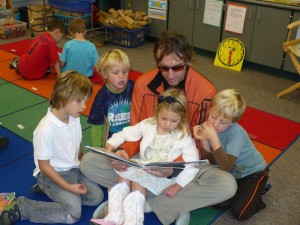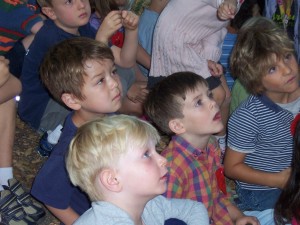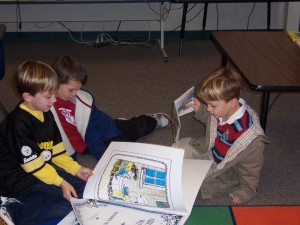This month’s Common Core State Standards based lesson in English/Language Arts provides you with a number of activities the teacher can implement for children to successfully demonstrate their understanding of retelling key ideas and details of a story.
Common Core Standard: English/Language Arts
Reading Standard for Literature: Key Ideas and Details
- With prompting and support, ask and answer questions about key details in a text.
- With prompting and support, retell familiar stories, including key details.
- With prompting and support, identify characters, settings, and major events in a story.
The goal of this standard, Key Ideas and Details, is for kindergartners to be able to retell a familiar story, including the main characters, the setting, and the major events of the story, recalling important details that are key to the text. There are a number of activities the teacher can implement for children to successfully demonstrate their understanding of this standard. Working in a whole group, small groups, and individually, students will be provided with scaffolded literacy experiences that will help them accomplish this retelling successfully. For the purpose of this sample lesson, we will use a story familiar to many children, The Little Red Hen.
In the tale, The Little Red Hen, a hen finds a grain of wheat and asks for help from the other farmyard animals (a pig, a duck, and a cat), to plant it. However, no animal will volunteer to help her. At each further stage (harvest, threshing, milling the wheat into flour, and baking the flour into bread), the hen again asks for help from the other animals, but again she gets no assistance. Finally, the hen has completed her task, and asks who will help her eat the bread. This time, all the previous non-participants eagerly volunteer. However, she declines their help, stating that no one aided her in the preparation work, and so she eats it with her chicks, leaving none for anyone else. The moral of this story is that those who show no willingness to contribute to an end product do not deserve to enjoy the end product (Wikipedia summary).
i) Whole group activity: Introduction to the story.
(1) Building background knowledge and investigating prior knowledge
(a) Teacher asks students:
(i) Who has ever made bread? Who knows what bread is made from? How does the wheat turn into flour? How is bread made? (Explain to students about flour and the process of making bread)
(ii) Who knows anything about hens, cats, dogs and pigs? What is the same about all of these animals? What is different? Where do they live? Do they talk and work around a barn?
(iii) Teacher tells students this is a folktale (explain what that is) and that this story is fiction (explain that) about a hen who lives with a cat, a dog, and a pig and that this is a story about a hen who works very hard to bake some bread. For English language learners, bring in some raw wheat, some flour, and some bread to help build the new vocabulary. Stop during the reading to demonstrate any unfamiliar words (i.e. thresh).
(2) Teacher reads the story out loud to the class.
(3) Teacher discusses the story and asks the students questions to check for understanding and help them make personal connections to the story:
Who are the characters in this story? Where does the story take place (the setting)? Is this story fiction or non-fiction? What happened in the story first? Then what happened, then what…..? What happened at the end? Why do you think the pig, the cat, and the dog didn’t want to help the hen? How would you feel if you were the hen? Why do you think the hen told them that they couldn’t have any of the bread? How would you feel if you were the pig, the cat, and the dog and the hen told you that you couldn’t have any of the bread? What do you think those animals might do differently next time the hen asked for help? What would you have done if you were the hen? What would you have done if you were the pig, the dog, or the cat? What would you do if someone asked you for help? How would you feel if you asked someone for some help and they told you no?
What was your favorite part? What did this story remind you of?
(4) Group class project:
(a) With teacher support, the class creates a story board mural of the story of the Little Red Hen. The children create the characters, a background of the setting (the barn), and they illustrate the different steps the hen took to make the bread, all in sequential order. Once the mural is done and it is hanging in the classroom, the students are encouraged to look at the pictures and retell the story to another student.
(5) Small group reading:
(a) Students in their juice groups share small copies of the book together in a guided reading group with a teacher. The teacher asks many of the same questions (above) with the students to check for understanding, sequencing, and retelling.
(b) Students draw a picture of their favorite part of the story. They dictate to the teacher what they want to say, and the teacher writes it down at the bottom of their picture. These “response to text” pieces get hung in the classroom for the children to share and retell with each other.
(a) Copies of the book are left available in the book corner so children can revisit the story on their own.
(7) Dramatic play:
(a) A hen, cat, pig, and dog puppets are in the dramatic play area so children can act out the story.
Not only will these activities build retelling skills, but they will strengthen comprehension skills, higher level thinking skills, critical thinking skills, sequencing skills, new vocabulary, receptive and expressive skills, and personal connections to text.
Nancy L. Cappelloni, Ed.D.
2011




Leave a Reply